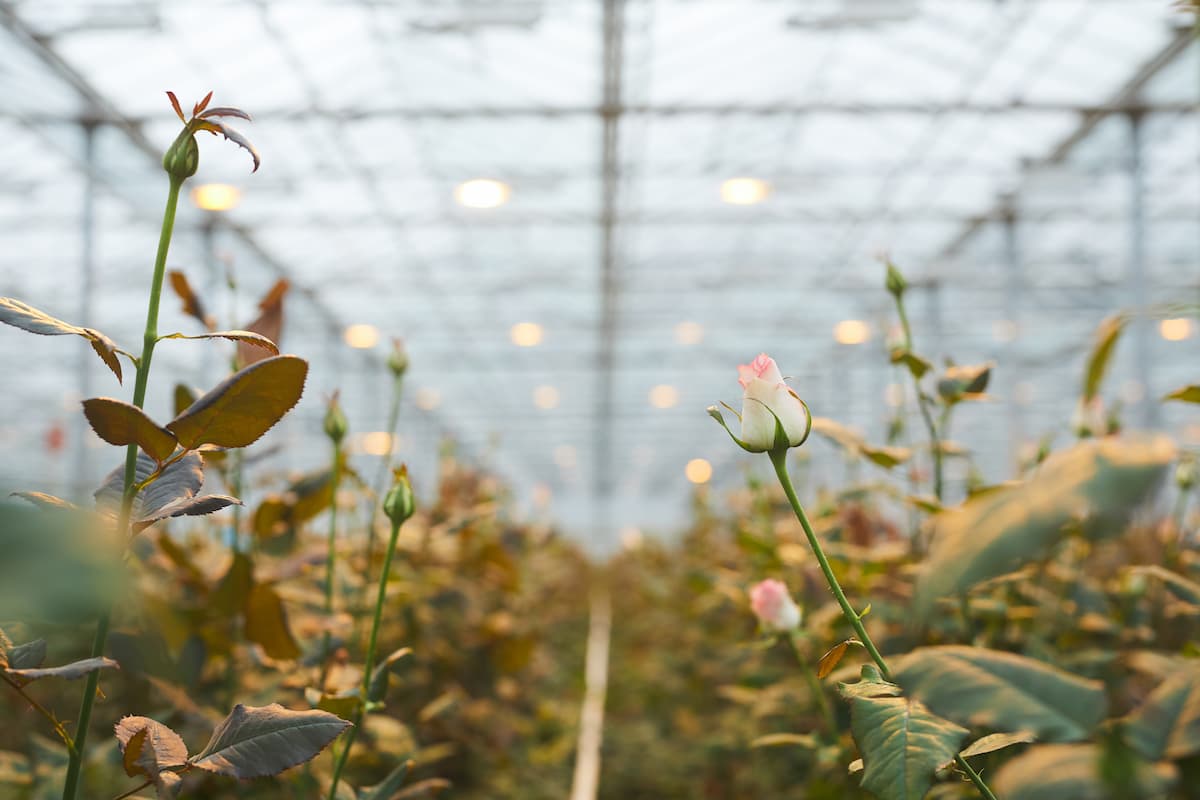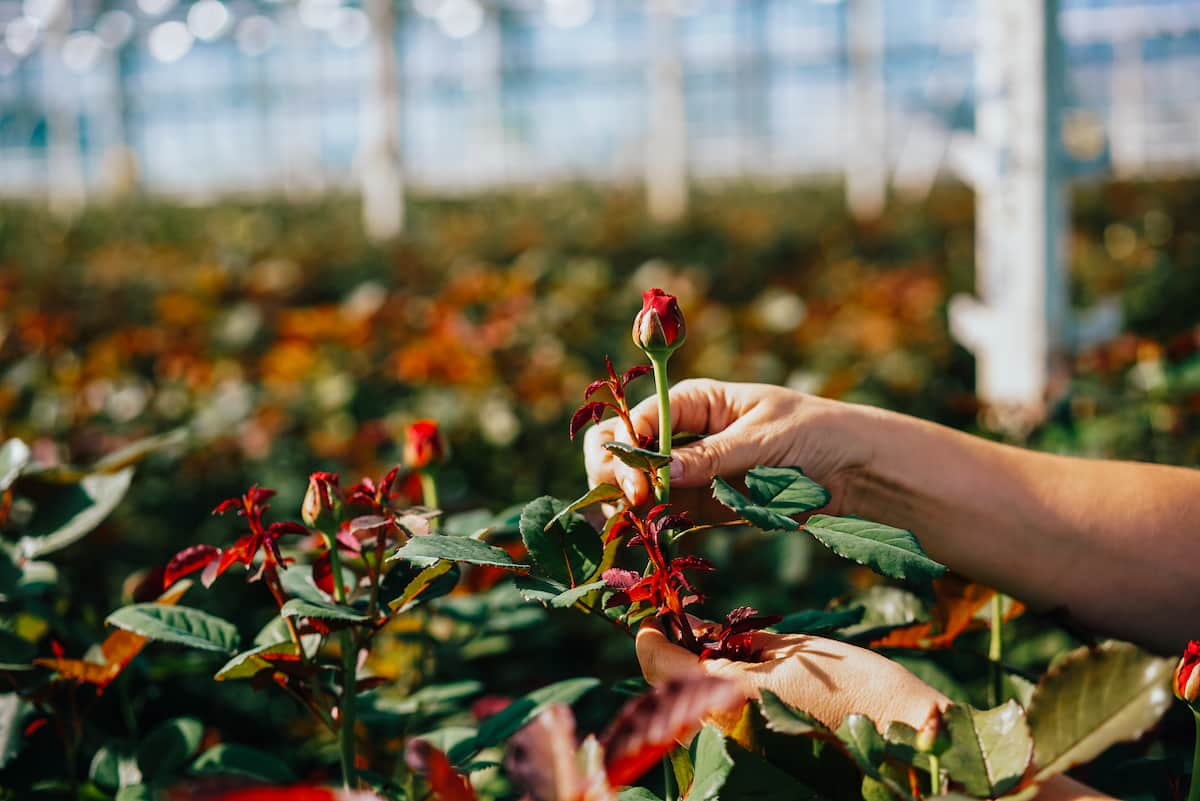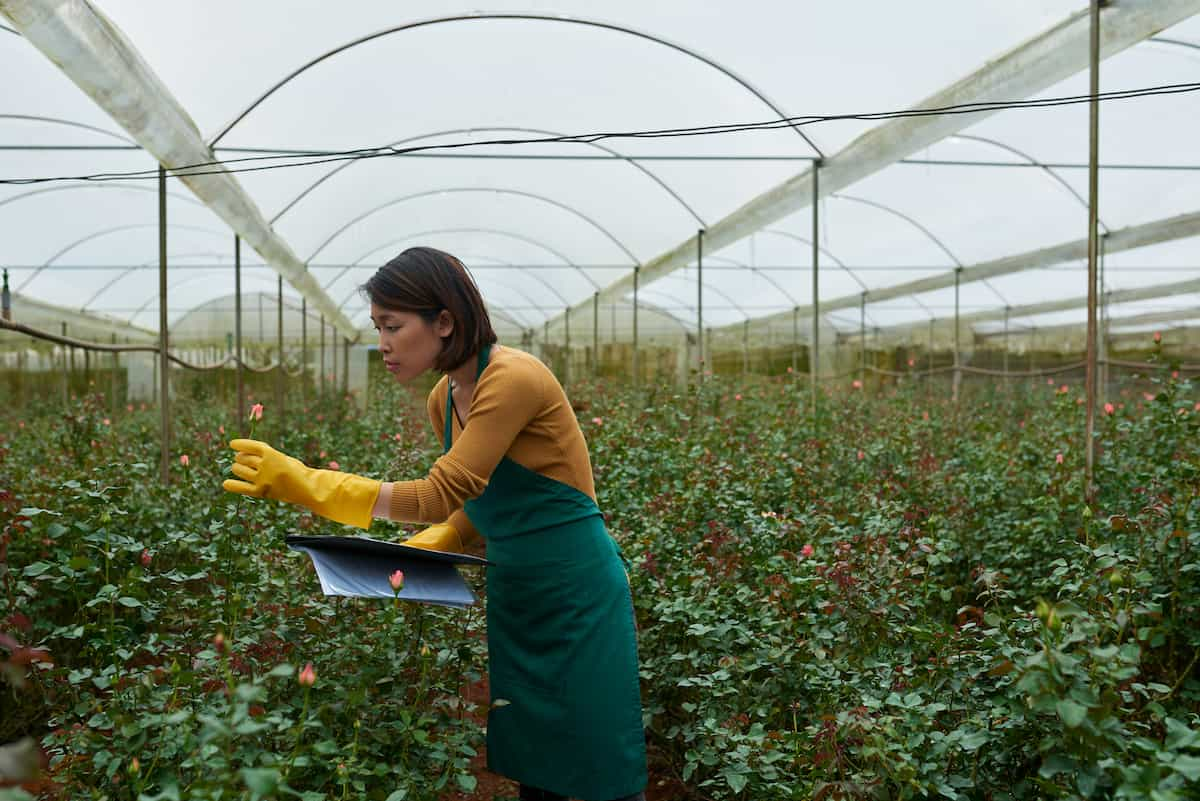There is no doubt that Roses are the queen of all flowers. As a symbol of love, they are highly popular around the world. Despite high demand, climate and soil type disparities make it difficult for Roses to grow in every region. This is where greenhouses come into play. In these buildings, Roses can be kept happy and healthy. In this guide, we discuss in detail how to grow Roses in a greenhouse. This includes species that are best suited to this environment as well.

How To Grow Roses in Greenhouse
Rose Varieties Best Suited For Greenhouses
| Queen Elizabeth | Little Flirt |
| Komsomolskiy light | Beauty Secret |
| Niccolo Paganini | Baccara |
| Carte Blanche | Casanova |
| Rose Gozhar |
Greenhouse Soil Requirements For Growing Roses
The soil in a greenhouse needs to be well-fertilized, fertile, and have an acidity index of 5.8-6.5. You should dig up the soil to a depth of 1.5-2 feet and apply organic fertilizer before planting Roses. While growing and blooming, Roses require a lot of nutrients. In closed environments, however, these sissies are sensitive to excess salts. Salty soil is especially harmful to young Rose seedlings. It is therefore recommended to add superphosphate before planting. Potassium, however, should be abundant in the soil. It is unlikely that Roses grown with such difficulty will survive long after being cut.
Light Requirements for Growing Roses in Greenhouse
Roses, with their bright colors, can’t tolerate prolonged darkness. Lighting must be uniform and bright enough for normal growth. They should receive six hours of sunlight a day at least. As much as possible, keep the greenhouse open to sunlight. Shade cloths should be used to shade the greenhouse during the summer.
In this way, the leaves will not be burned. In general, Roses are extremely susceptible to leaf damage. When caring for plants, this must be considered. Artificial lighting should be included in the greenhouse if you cannot get 6 hours of sunlight during the fall and winter. The perfect conditions can be provided by grow lights.
Climatic Requirements for Growing Roses in Greenhouse
Keep daytime temperatures at 20-21°C and nighttime temperatures at 16-18°C. The production time of plants can be increased by two weeks if grown at temperatures below 18°C. Ensure greenhouses are properly ventilated to prevent cold air from falling on plants, making them more susceptible to disease. Relative humidity of 60-70 percent should be maintained. A higher relative humidity of up to 85 percent can be used temporarily to encourage shoot development after pinching.
Planting Rose Cuttings in Greenhouse
- Choose a spot where watering will be easy, and the Rose will receive at least six hours of sunlight daily.
- You should mix equal amounts of compost and soil. Dig a hole twice the width of the root ball and add a mound of the mixture to the center of the hole.
- Dig a planting hole at least 50 cm wide and 50 cm deep, wide enough for roots to spread and deep enough to prevent soil erosion.
- Fill the hole with water (to saturate the soil before planting), then allow it to drain.
- Remove the Roses from the shipping material. Pruning shears should be used to cut off any broken or shriveled roots. In a bucket of water, soak the remaining roots for six hours.
- You should place the graft 2 to 3 inches above the soil line. When filling the pot or hole, tamp the soil lightly in place. Ensure the soil mixture is thoroughly watered, and add more if necessary.
- After the hole has been improved, fill it with soil from that hole. Make a shallow depression to allow water to drain into the newly planted Rose.
- Water again with a solution of seaweed nutrients after firming the soil. When planting, do not fertilize, as it will burn the roots and cause them to die back.
- Water your Rose daily as new growth appears; don’t let it dry out until it is established (this can take 10-12 weeks).
In case you missed it: How to Grow Stevia in Greenhouse: A Step-By-Step Guide for Seed to Harvest

Irrigation Requirements for Growing Rose Plants in Greenhouse
Water is essential for Roses; they need one to two inches a week. Depending on the bush size, even more, may be needed during the hot, dry season. While Roses need abundant water, they dislike standing in it, so drainage must be provided. It is best to irrigate your Rose plants in the morning. Avoid watering Roses in the evening to prevent powdery mildew, a common disease. During the rainy season, watering will only be necessary during dry periods.
Fertilizing Requirements for Growing Rose Plants in Greenhouse
Roses will benefit from a steady nitrogen, phosphorus, and potassium supply as heavy feeders. Approximately 5-8-5 is the ratio you should use when fertilizing liquids and granular. Roses can be fed all their nutritional needs by applying compost, rotted manure, fish emulsion, and seaweed extracts regularly. Also, these organic amendments help to moderate pH imbalances and stimulate soil life. Rose growers also prefer greensand, black rock phosphate, and alfalfa meal as organic amendments.
Mulching for Growing Rose Plants in Greenhouse
Mulching reduces weed infestation and maximizes irrigation water efficiency. Mulching can be done using various materials, such as dry plant leaves and paddy straws. Adding 6-8 cm of dried leaves of Jamun tree to Rose beds in April prevents weeds from growing for at least two months, in May and June, and reduces their reappearance in the following months.
Weeding and Hoeing for Growing Rose Plants in Greenhouse
Neglecting weeding can result in a decline in flower quality and yield. The most prevalent weeding method is manual weeding. Hoeing Rose beds at fortnightly intervals remove weeds and loosen soil for better aeration and moisture retention. Deep hoeing destroys fibrous roots, so shallow hoeing is preferred.
Pruning Rose Plants Growing in Greenhouse
Increasing shrub depletion is a significant risk when growing Roses in greenhouses. Therefore, only the central branches should be left after trimming the weaker branches. As a result, the shoots form larger, stronger flowers. There are several functions performed by cutting shoots that are considered equally important:
- Lengthen the flowering period
- Improvement of the bush and its rejuvenation
- Proper shrub formation
Harvesting Roses
Pick your Rose flowers early in the morning or late in the evening rather than in the middle of the day. This is because the plant’s water content is high, and the temperatures are ideal. Make cuts in the plant to get long, robust stems. It is advisable to remove the foliage from the branches that will be submerged since it will rot and promote bacterial growth. Stems can be trimmed straight or slanted. A slanting cut prevents stems from sitting flat on the bucket bottom, which allows them to absorb more water
In case you missed it: How to Grow Cloves in a Greenhouse: A Step-by-Step Guide for Seed to Harvest

Conclusion
The benefits of growing Roses in a greenhouse can be considerable if you consider starting or expanding your Rose flower farm. The advantages include fewer pests and diseases and more control over temperature, humidity, and soil composition. You can also control weeds when growing Roses in a greenhouse.
- Feed Your Flock for Less: Top 10 Tips to Save on Chicken Feed
- Ultimate Guide to Ossabaw Island Hog: Breeding, Raising, Diet, and Care
- Hatching Answers: The Top 10 Reasons Your Chickens Aren’t Laying Eggs
- Eggs and Economics: Breaking Down the Cost of Raising Backyard Chickens
- Defend Your Greens: Proven Methods to Keep Iguanas Out of Your Garden
- Ultimate Guide to Cinnamon Queen Chicken: A Comprehensive Guide for Beginners
- Ultimate Guide to California Tan Chicken: Breeding, Raising, Diet, Egg-Production and Care
- Ultimate Guide to Marsh Daisy Chicken: Breeding, Raising, Diet, and Care
- 10 Types of Chicken Farming Businesses You Can Start for Profits